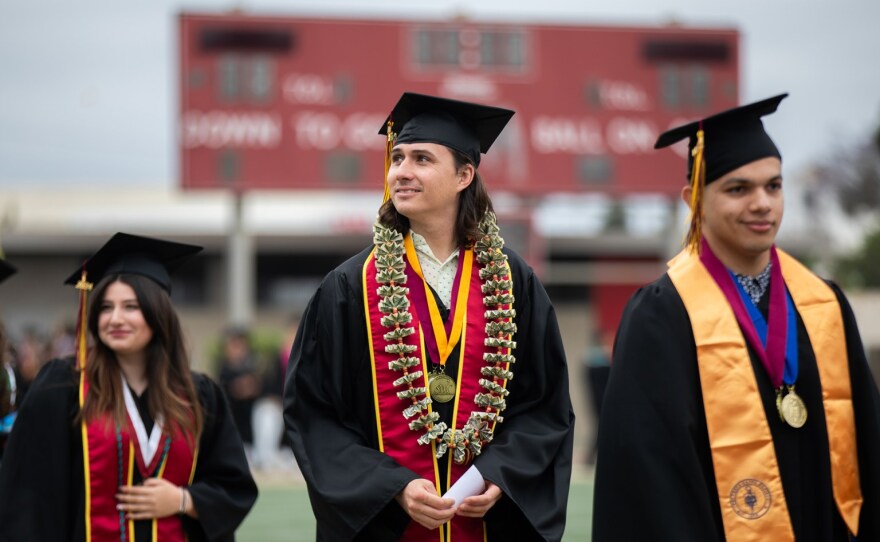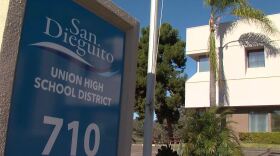By 2027 students in South County San Diego County will be able to earn eight different bachelor’s degrees from three public universities while enrolled in the new Chula Vista University. That’s before it even has a campus.
The university, which opens for class next year, promises a novel approach to higher education, as a hybrid institution with programs from San Diego State, Cal State San Marcos, UC San Diego and Southwestern College.
It’s part of a long-awaited plan to bring a four-year campus to the city of Chula Vista. City officials have pursued that goal for decades, seeking state support and buying land for an eventual campus. Assemblymember David Alvarez, a Democrat from the community, made it his top priority when he was elected in 2022.
“South County has long been considered a college desert,” Alvarez said at a town hall meeting on the project Saturday. “This is one of the most diverse, fastest growing parts of the state, yet it has been underserved in regards to higher education.”
Chula Vista introduced its vision for the campus as part of its city plan in 1993, Alvarez said. In 2006 California education leaders and local officials proposed building a combined university and research park, so students could live, learn and ultimately work in their own community.
By 2014 the city acquired 383 acres of land for the new campus. But in 2017 the state Legislative Analyst’s Office concluded that there wasn’t enough enrollment demand to justify building a single UC or Cal State campus.
“Reports were that it wasn’t the right time,” Alvarez said in a video about the project. “That California didn’t need another public university.”
While the state might not need one, proponents insisted that South County San Diego did. So they agreed on a multi-institutional campus to train students for key jobs. This would be more focused than a traditional liberal arts university, with degrees targeted at regional workforce needs in fields such as nursing, public health, business and education.
Alvarez got to work on the project as soon as he was sworn in. He secured $25 million for the city’s Millennial Library, which will open next fall and host one of the first degree programs. And he introduced a law to reserve the accumulated land for the university project, and another to form a task force to guide development of the campus.
Gov. Gavin Newsom signed that law this month, authorizing the South County Higher Education Task Force to study governance models for the higher education facility, including how the different university systems interact, how they will share authority and resources, and how to pay for the new campus. It will include representatives from the Cal State and UC systems, Southwestern College, the legislature, city and local high school district. Its report on the project is due by July, 2027.
The initial phase of the campus will cost an estimated $2.17 billion, according to an architectural report, and would consist of “a walkable campus gathered around a central open space.” Conceptual drawings show light-filled buildings with wall-to-wall windows, and walkways meandering around landscaped commons and decorative ponds.
The task force will consider those plans, and decide when to start construction and how to fund it. Although the full campus hasn’t even broken ground, Chula Vista University is slated to start degree programs next year.
“While the end goal is the university campus, it also became clear to me that we need and deserve university education now,” Alvarez said.
In fall 2026, it will offer a bachelor’s degree in nursing at classrooms in the Millennial Library, which is now slated to open at the same time.
It will also introduce degrees in industrial psychology from San Diego State, business administration, computer information systems and cybersecurity from Cal State San Marcos, and public health from UC San Diego. In fall, 2027, Cal State San Marcos will add degrees in bilingual speech pathology and human development. All those programs would be located at Southwestern College.
Proponents are also exploring the potential for accelerated degrees in hospitality, kinesiology and public administration from San Diego State, Alvarez said. They’re discussing cross-border programs with Mexican universities. And they may collaborate on film and TV pathway programs with the upcoming Chula Vista Entertainment Complex, a production studio set to open in the Millennial Library.
These joint ventures across institutions and locations aren’t typical, but Alvarez points to nearby Cal State San Marcos, now one of the fastest-growing CSU schools. It launched its first programs as a satellite branch of San Diego State in a middle school in 1979, before expanding to a nearby strip mall, and then building its campus on a former chicken ranch a decade later.
“The research demonstrated to me that a world-class university often starts with humble beginnings,” Alvarez said.
As part of their planning, Alvarez and other proponents visited Auroria Campus in Denver Colorado. It’s a hybrid facility that hosts Community College of Denver, Metropolitan State University of Denver, and University of Colorado Denver. However, Alvarez said Chula Vista University will be unique for California.
“We are building something new, so we have to figure out how to do that,” he said. “They’ll also work to identify funding sources for both the construction of the physical campus and for the long-term operation of the university campus. Those are big commitments that we need to make.”
This article was originally published on CalMatters and was republished under the Creative Commons Attribution-NonCommercial-NoDerivatives license.






